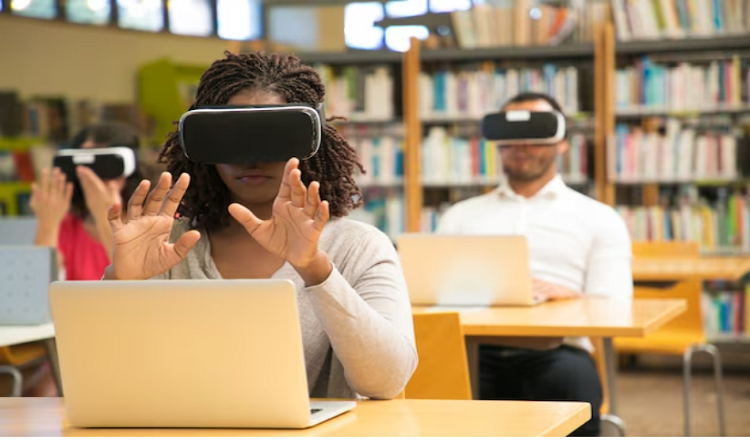Virtual reality (VR) is no longer just a futuristic concept in science fiction movies, it’s a reality that’s rapidly making its way into many industries, including education. VR has the potential to revolutionize the way we learn and experience knowledge, making education more immersive, engaging, and accessible to all. But what exactly is VR, and how is it being used in education and e-learning?
Overview of VR in education and e-learning: VR is a simulated experience that can be similar to or completely different from the real world. It is achieved through the use of a headset that tracks the user’s head movements, allowing them to look around the virtual environment. In education, VR is being used to create interactive and immersive learning experiences, from virtual field trips to collaborative simulations. E-learning, on the other hand, can incorporate VR into online courses, offering students a more engaging and interactive way to learn from anywhere.
The purpose of this article is to explore the exciting world of VR in education and e-learning, examining the benefits and challenges of using this technology in the classroom. We’ll take a look at the different ways VR is being used in education, from enhancing traditional teaching methods to creating virtual classrooms. Additionally, we’ll discuss the future of VR in education and e-learning, and what this means for students and educators. Whether you’re a teacher, student, or just curious about the future of education, this article is for you. So, put on your VR headset, and let’s dive into the world of virtual reality in education.
The Advantages of Using VR in Education
- Immersive learning experience: One of the biggest advantages of VR in education is the immersive learning experience it provides. VR technology allows students to fully immerse themselves in a virtual environment, providing a level of engagement that’s difficult to achieve with traditional methods. From virtual field trips to interactive simulations, VR brings subjects to life, making them more memorable and enjoyable for students. Imagine taking a virtual tour of ancient Rome, exploring its buildings and monuments as if you were actually there. That’s the kind of immersive learning experience VR can provide.
- Increased engagement and motivation: VR technology also has the potential to increase student engagement and motivation. When students are engaged and motivated, they’re more likely to retain information and perform better on exams. VR provides a dynamic and interactive learning experience, making education more engaging and fun. For example, instead of just reading about the human body in a textbook, students can explore the anatomy in a virtual environment, making it easier to understand and remember the material.
- Better retention of information: Studies have shown that students retain more information when they’re engaged in an immersive and interactive learning experience, like the ones provided by VR. This is because VR technology allows students to experience a subject in a new and exciting way, making the material more memorable. When students are able to see, touch, and experience a subject in a virtual environment, they’re more likely to retain the information and apply it in the future.
- Accessibility for all students: VR technology also has the potential to make education more accessible to all students, regardless of their physical abilities or location. For example, students with physical disabilities can use VR technology to experience field trips and simulations, providing them with the same learning opportunities as their peers. VR can also provide students in remote areas with access to high-quality education, without having to leave their communities.
- Cost-effectiveness: Finally, VR technology can also be cost-effective in the long run. While the initial cost of VR equipment and technology can be high, it can provide a more cost-effective solution than traditional field trips and simulations. With VR, students can take virtual field trips to multiple locations, without the need for transportation or accommodations. In addition, VR simulations can replace expensive equipment and materials, providing students with a safe and cost-effective way to learn and experiment.
VR in E-Learning
- Interactive online courses: VR technology is transforming the way we approach online courses, making them more interactive and engaging. Online courses are no longer limited to text-based learning and static images. With VR, students can experience interactive simulations, virtual field trips, and even virtual classrooms, providing them with a more immersive and enjoyable learning experience. Online courses that incorporate VR have the potential to improve student engagement and motivation, making it easier to retain information and perform better on exams.
- Virtual classrooms: VR technology also provides the opportunity for virtual classrooms, allowing students to attend class from anywhere in the world. This can be especially beneficial for students who live in remote areas or for those who are unable to attend traditional classes due to physical disabilities. Virtual classrooms also provide a more flexible and convenient option for students, allowing them to attend class at their own pace and on their own schedule.
- Virtual field trips: VR can also be used in e-learning to provide virtual field trips, allowing students to explore and experience real-world locations without ever leaving the comfort of their own home. For example, students can take a virtual tour of a historical site, learn about different cultures, or even explore the depths of the ocean. Virtual field trips provide an exciting and interactive way to learn, making education more enjoyable and memorable.
- Collaborative learning: VR technology can also be used to support collaborative learning, allowing students to work together on simulations and projects in a virtual environment. Collaborative learning provides students with the opportunity to learn from one another, improve their communication skills, and develop a deeper understanding of a subject. With VR, students can work together in virtual classrooms or virtual environments, providing them with a unique and engaging learning experience.
- Skill development and simulations: Finally, VR technology can be used in e-learning to develop skills and conduct simulations. For example, students can practice surgery in a virtual environment, improving their skills and reducing the risk of harm to real patients. VR simulations can also be used to teach safety procedures, crisis management, and other critical skills, providing students with a safe and controlled environment to learn and experiment.
Future of VR in Education and E-Learning
- Advancements in VR technology: As VR technology continues to evolve and improve, we can expect to see more advanced and immersive VR experiences in the world of education and e-learning. The future of VR in education will likely be characterized by more sophisticated simulations, virtual environments, and online courses, providing students with a more engaging and interactive learning experience. The advancements in VR technology will also likely make VR more accessible and affordable, making it easier for schools and universities to adopt and implement VR in their curriculum.
- Increased investment in VR education: With the growing popularity of VR in education, we can expect to see an increase in investment in VR education. This investment will likely lead to the development of new and innovative VR educational experiences, making VR an even more valuable tool for students and teachers alike. The investment will also help to drive the adoption of VR technology in schools and universities, making VR an integral part of the educational landscape.
- Wider adoption and implementation in schools and universities: As VR technology continues to improve, we can expect to see a wider adoption and implementation of VR in schools and universities. This wider adoption will likely lead to an increase in the number of VR-based courses, programs, and educational experiences, providing students with more opportunities to learn and explore the world of VR. The wider adoption will also help to improve the quality of VR educational experiences, making VR an even more valuable tool for students and teachers alike.
- Integration with AI and machine learning: Another exciting future trend in VR in education is the integration of VR with AI and machine learning. This integration will likely lead to the development of more personalized and adaptive learning experiences, providing students with a more tailored and engaging learning experience. For example, AI-powered VR simulations could help students identify and overcome their individual learning challenges, making education more effective and efficient.
- Personalized and adaptive learning experiences: Finally, the future of VR in education will likely be characterized by more personalized and adaptive learning experiences. With VR, students will be able to learn at their own pace, on their own schedule, and in their own style, providing them with a more effective and enjoyable learning experience. VR technology will also likely help to personalize educational experiences, allowing students to explore and interact with virtual environments in a way that is meaningful and relevant to their individual interests and goals.
In conclusion, the future of VR in education and e-learning is exciting and full of potential. With advancements in VR technology, increased investment in VR education, wider adoption and implementation in schools and universities, and integration with AI and machine learning, we can expect to see an even more immersive, interactive, and personalized VR learning experience in the years to come. Whether you’re a student, teacher, or educational institution, it’s definitely worth exploring the exciting world of VR in education and e-learning.




